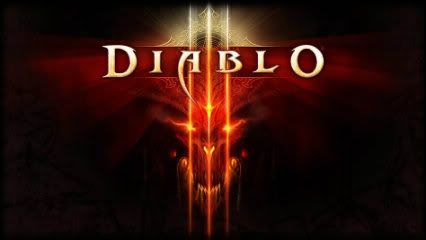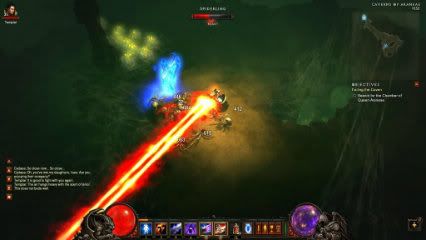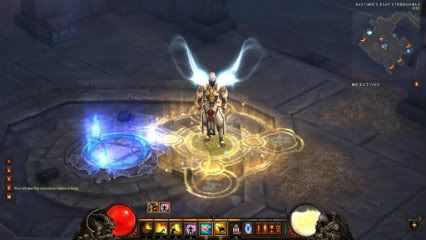
- Format: PC (version reviewed), Mac
- Unleashed: Out Now
- Publisher: Blizzard Entertainment
- Developer: Blizzard Entertainment
- Players: 1-4
- Site: http://www.diablo3.com
It’s been over ten years since the last Diablo game and those, like us, of a certain age will fondly remember our time spent with it as an RPG focused on MMO style goals of finding bigger and better gear to fight bigger and stronger monsters. With great anticipation comes the potential for ultimately being greatly disappointed, so where does Diablo 3 fall?
Usually we prefer to get straight into the game, but in order to get into Diablo 3 you must first traverse what has become the universally hated mechanic of the ‘always-on’ system meaning regardless of whether you wish to play alone or with friends, you must always be online on Blizzard’s servers. Perhaps not a huge hurdle to overcome you might be thinking and you may be right, given that most people have a reasonable connection that is always on; however there are problems outside this.

During our time with Diablo 3 we had periods where the battle.net servers struggled to allow people to authenticate, other times they were just down and other times they were congested with lag. At first we were willing to ignore this as simply a by-product of an extremely successful launch, but over a week in and these problems are still persisting. The worst of these is that even if you are playing the game alone as single player you may experience lag. It’s utterly unacceptable and a truly horrible system purported to be in order to maintain a real money auction house (which has yet to be added) and comes across more as a truly desperate means to defend against piracy and collect player information.
Get through all that and you may get to experience the actual game. Diablo 3 is set 20 years after the events of the previous game when the character of your choice (Monk, Demon Hunter, Barbarian, Wizard or Witch Doctor) comes to New Tristram as a star falls from the sky and triggers the resurrection of a ruthless, undead king.
The plot is run of the mill with obvious double crosses and revelations (assuming you’re familiar with previous games) with the only real interest coming from back and forths you may have with your companions or overheard conversations between NPCs which can often be genuinely funny. These aren’t particularly negatives though since the appeal of these games is more in the gameplay itself and the urge to keep replaying – which a story-heavy plot would deter. That said, the CG cutscenes at the end of each of the four acts are among the highest quality we have ever seen.

With your chosen class you will visit a variety of locations slashing, blasting or punching all manner of creative enemies gaining levels, skills and gear as you go. Gone is the point distribution system of Diablo 2 and in its place is a progressive learning system which avoids the chance of making a bad build and instead lets you switch up skills you have access to on the go. It may seem like dumbing down and in a manner of speaking it is, but variety is still there between the classes themselves and the different combinations of skills and runes you can equip.
What doesn’t help creating the impression of dumbing down is the lack of detail in the description of skills and runes and the ability to select more than one skill from a tree, and we were mystified as to why options like ‘advanced tool tips’ and ‘elective mode’ weren’t on by default – it felt condescending to say the least.
Combat is incredibly visceral and detailed. The power behind each hit you deal out is really felt both because of the sound effects and the variety of ways monsters react. The element of your weapon, the type of attack and even the angle you attack from all affect how things die. It sounds small but it’s little touches like that and within the destructible scenery that keeps gameplay feeling strangely fresh. It’s hard to deny the satisfaction of unleashing an ability on a monster and, after a large splatter of blood, seeing just its skeleton flop to the ground.

Addictive gameplay is what saves Diablo 3, at the end of the day. Fast, furious, compelling battles backed up by some randomised events and dungeons to become distracted with. It’s one of those games you can just get lost in over and over. Normal mode is a little easy but once you unlock higher difficulties things really take off and for the real sadists there’s a hardcore mode which has death being permanent. Music is great, voice acting is decent, graphics are impressive, and the classes feel similar enough to those in former games while also being unique from one another.
We feel it necessary when scoring Diablo 3 to score it as a game regardless of the outside grievances that we’ve already mentioned and it is a fun game. The score below reflects this. However, we would reiterate the inevitable frustration and annoyance that may occur due to the appalling and poorly implemented ‘always on’ system (for which this game will forever be used as a perfect example of why it doesn’t work). If you wish the score below to reflect the problems we had with this aspect, subtract at least two points.
















Comments